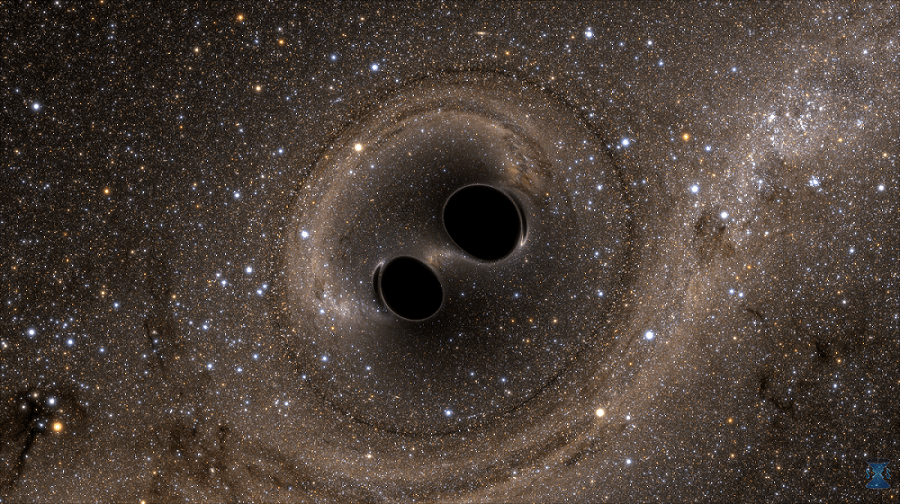The early Universe was swimming with dwarf galaxies only a few hundred million years after the Big Bang. They merged with each other over time, building larger and more massive galaxies. At the same time, the giant black holes inside these dwarfs merged, too.
That’s the current story of galaxy growth and evolution that astronomers understand. And, such collisions likely tell the story of our own galaxy’s early history. Now, astronomers have found the actual first evidence for giant and possibly supermassive black holes in dwarf galaxies on a collision course. No, they haven’t looked back that far in time. That’s nearly impossible to do right now. So, they did the next best thing: they looked at dwarf galaxy collisions closer to home.
Dwarf Galaxies and Black Holes

Dwarf galaxies exist throughout the Universe. They’re usually quite small, often with a few billion stars. There are various flavors of dwarf galaxies—such as dwarf spheroidals and ultracompact dwarfs. Until relatively recently, astronomers weren’t sure that such little galaxies had central black holes. Now they know that some do have intermediate-mass black holes. A good example is the tiny galaxy called Fornax Ultracompact Dwarf 3. It turns out to have a fairly massive black hole.
If dwarf galaxies have black holes and if dwarfs collided in the early Universe to make bigger galaxies, then could those black holes have collided to make supermassive ones? That is a question scientists set out to answer, using the Chandra X-ray Observatory.
“Astronomers have found many examples of black holes on collision courses in large galaxies that are relatively close by,” said Marko Micic of the University of Alabama at Tuscaloosa. He led a new study that looked for evidence of such mergers in faraway galaxies. “But searches for them in dwarf galaxies are much more challenging and until now had failed.”
Finding Evidence of Black Hole Collisions in Dwarf Galaxies
To understand what actually happened “back then”, Micic and his team observed dwarf galaxy collisions in regions closer to home. They then used what they found to make predictions about what happened in the early Universe. First, they made deep survey observations with Chandra. It looked for superheated material surrounding the collisions of dwarfs and their supermassive black holes. Such hot regions give off prodigious amounts of x-rays, which Chandra detects. That superheated material is also what feeds black holes.
The team then compared the observations with infrared data from NASA’s Wide Infrared Survey Explorer (WISE) and optical data from the Canada-France-Hawaii Telescope (CFHT). Essentially, they looked for pairs of bright x-ray sources in colliding dwarf galaxies. Those sources reveal the location of the black holes in the two merging galaxies.
What Did The Team Find?
The data methods revealed some likely candidate collisions between supermassive black holes inside dwarf galaxies. According to Micic’s co-author, Olivia Holmes, “We’ve identified the first two different pairs of black holes in colliding dwarf galaxies,” she said. She also noted that they provide helpful clues to earlier events. “Using these systems as analogs for ones in the early universe, we can drill down into questions about the first galaxies, their black holes, and star formation the collisions caused.”
The collisions between the pairs of dwarf galaxies have pulled gas toward the giant black holes they each contain. That set up a feeding frenzy, causing each black hole to grow. Eventually, the likely collision of the black holes will create larger black holes as their galaxies merge.

One pair is in the galaxy cluster Abell 133, which lies some 760 million light-years away. The science team nicknamed the pair “Mirabilis”. That’s after a hummingbird species with long tails. The two dwarf galaxies are in the late stages of their merger and show a long tail of material stirred up by the tidal effects of their gravitational dance. Their merger is nearly complete.
The team observed a second pair of merging dwarf galaxies in the galaxy cluster Abell 1758S. It’s about 3.2 billion light-years away. Its merging galaxies are called “Elstir” and “Vinteuil”, after two fictional characters in Marcel Proust’s “In Search of Lost Time.” These two objects are actually just beginning their merger, but already their black hole interactions are showing characteristic x-ray activity.
Implications of Mergers
Following the hierarchical theory of galaxy evolution, the little ones merged in the early Universe, creating larger and larger ones as more mergers took place. If they had black holes, and we know that black holes existed in those early epochs, then the black holes should have merged, too. Not only do observations like these provide a way to figure out if this is what happened in the early Universe, but they also give us a sneak peek at our own galaxy’s history.
The Milky Way, for example, is still cannibalizing dwarf galaxies today, some 13.6 billion years after it first began to form. Currently, astronomers know that about 50 dwarfs surround the Milky Way. Our galaxy is ingesting some of them, like the Sagittarius Dwarf.

Early in its history, the earliest ancestor of the Milky Way collided with a neighbor called Gaia-Enceladus. That collision, which took place about 10 billion years ago, enriched the infant Milky Way and spurred a wave of star formation that helped fill our galaxy out. It’s very likely that collisions of central black holes also occurred. They led to the formation of Sagittarius A*, the central supermassive black hole that exists at the Milky Way’s heart today.

Looking at galaxy mergers and black hole collisions across time should help astronomers fill in the gaps of knowledge about how all galaxies, including the Milky Way, have grown and changed over time. This new study gives them a chance to start with dwarf galaxies—the early building blocks of galaxies like our Milky Way.
For More Information
NASA’s Chandra Discovers Giant Black Holes on Collision Course
Two Candidates for Dual AGN in Dwarf-Dwarf Galaxy Mergers

